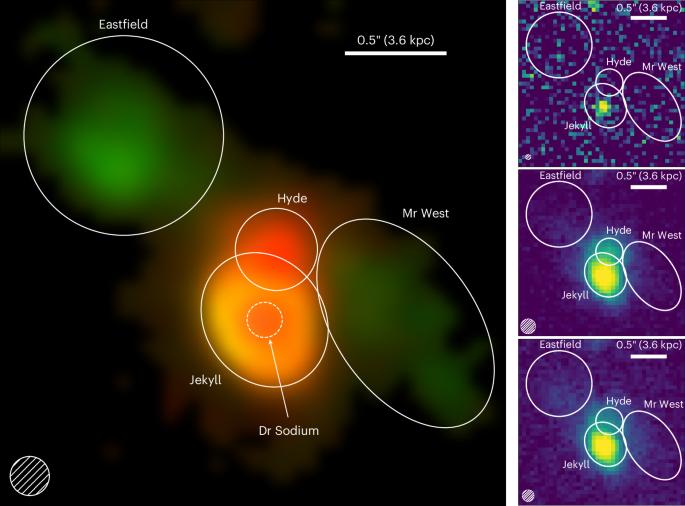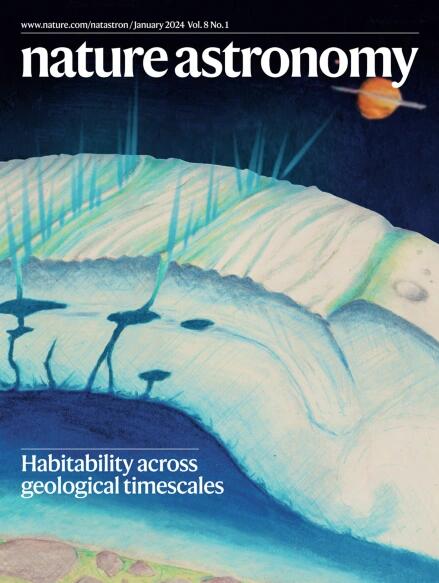Accelerated quenching and chemical enhancement of massive galaxies in a z ≈ 4 gas-rich halo
IF 14.3
1区 物理与天体物理
Q1 ASTRONOMY & ASTROPHYSICS
引用次数: 0
Abstract
Stars in galaxies form when baryons radiatively cool down and fall into dark matter-dominated gravitational wells. Eventually, star formation quenches as gas is depleted and/or perturbed by feedback processes that prevent the gas from collapsing and condensing. Here we report spatially resolved spectroscopic observations, using the JWST/NIRSpec integral field unit, of a massive, quiescent galaxy (Jekyll) and its neighbourhood at redshift z = 3.714, when the Universe age was 10% of today’s. Jekyll resides in a massive dark matter halo (MDM > 1012 M⊙) forming a galaxy pair with Hyde, which shows intense dust-enshrouded star formation (star-formation rate ~300 M⊙ yr−1). We find large amounts of kinematically perturbed ionized and neutral gas in the circumgalactic medium around the pair. Despite this large gas reservoir, Jekyll, which formed a stellar mass of 1011 M⊙ in stars and chemically enriched early (first billion years of the Universe) and quickly (200–300 Myr), has remained quiescent for over 500 Myr. The properties of the gas found around the two galaxies are consistent with intense, active galactic nucleus-induced photoionization, or intense shocks. However, with the current data, no obscured or unobscured active galactic nucleus is detected in the central galaxy (Jekyll) nor in the very active star-forming galaxy (Hyde). Our study points to a closed-box model followed by preventive feedback to explain the formation and early quenching of massive galaxies in the first 2 Gyr of the Universe. Spatially resolved JWST spectroscopy of a massive, quiescent galaxy at a redshift of ~4 reveals that it formed its stars and quenched rapidly, despite being surrounded by an abundant gas reservoir and gravitationally bound to a star-bursting companion.


z≈4富气晕中大质量星系的加速猝灭和化学增强
当重子辐射冷却并落入暗物质主导的引力井时,星系中的恒星就形成了。最终,由于气体耗尽和/或受到阻止气体坍缩和冷凝的反馈过程的干扰,恒星的形成会熄灭。在这里,我们报告了空间分辨光谱观测,使用JWST/NIRSpec积分场单元,在红移z = 3.714处,一个大质量的静止星系(Jekyll)及其邻近星系,当时宇宙年龄是今天的10%。Jekyll位于一个巨大的暗物质晕(MDM > 1012 M⊙)中,与Hyde形成一对星系,后者显示出强烈的尘埃笼罩的恒星形成(恒星形成速率~300 M⊙yr−1)。我们在这对星系周围的星系介质中发现了大量的运动扰动电离气体和中性气体。尽管有这么大的气体储层,杰基尔在恒星中形成了1011 M⊙的恒星质量,并且在早期(宇宙的第一个十亿年)和快速(200-300迈)中化学富集,在500迈以上保持静止。在这两个星系周围发现的气体的性质与强烈的、活跃的星系核引起的光电离或强烈的激波一致。然而,根据目前的数据,在中央星系(杰基尔)和非常活跃的恒星形成星系(海德)中都没有发现被遮挡或未被遮挡的活动星系核。我们的研究指向了一个封闭的盒子模型,然后是预防性反馈,以解释宇宙前2 Gyr中大质量星系的形成和早期淬火。
本文章由计算机程序翻译,如有差异,请以英文原文为准。
求助全文
约1分钟内获得全文
求助全文
来源期刊

Nature Astronomy
Physics and Astronomy-Astronomy and Astrophysics
CiteScore
19.50
自引率
2.80%
发文量
252
期刊介绍:
Nature Astronomy, the oldest science, has played a significant role in the history of Nature. Throughout the years, pioneering discoveries such as the first quasar, exoplanet, and understanding of spiral nebulae have been reported in the journal. With the introduction of Nature Astronomy, the field now receives expanded coverage, welcoming research in astronomy, astrophysics, and planetary science. The primary objective is to encourage closer collaboration among researchers in these related areas.
Similar to other journals under the Nature brand, Nature Astronomy boasts a devoted team of professional editors, ensuring fairness and rigorous peer-review processes. The journal maintains high standards in copy-editing and production, ensuring timely publication and editorial independence.
In addition to original research, Nature Astronomy publishes a wide range of content, including Comments, Reviews, News and Views, Features, and Correspondence. This diverse collection covers various disciplines within astronomy and includes contributions from a diverse range of voices.
 求助内容:
求助内容: 应助结果提醒方式:
应助结果提醒方式:


